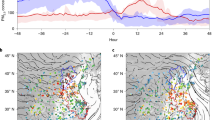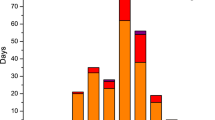Abstract
The frequency of Beijing winter severe haze episodes has increased substantially over the past decades1,2,3,4, and is commonly attributed to increased pollutant emissions from China’s rapid economic development5,6. During such episodes, levels of fine particulate matter are harmful to human health and the environment, and cause massive disruption to economic activities3,4,7,8,9,10,11,12,13,14,15,16, as occurred in January 201317,18,19,20,21. Conducive weather conditions are an important ingredient of severe haze episodes3,21, and include reduced surface winter northerlies3,21, weakened northwesterlies in the midtroposphere, and enhanced thermal stability of the lower atmosphere1,3,16,21. How such weather conditions may respond to climate change is not clear. Here we project a 50% increase in the frequency and an 80% increase in the persistence of conducive weather conditions similar to those in January 2013, in response to climate change. The frequency and persistence between the historical (1950–1999) and future (2050–2099) climate were compared in 15 models under Representative Concentration Pathway 8.5 (RCP8.5)22. The increased frequency is consistent with large-scale circulation changes, including an Arctic Oscillation upward trend23,24, weakening East Asian winter monsoon25,26, and faster warming in the lower troposphere27,28. Thus, circulation changes induced by global greenhouse gas emissions can contribute to the increased Beijing severe haze frequency.
This is a preview of subscription content, access via your institution
Access options
Access Nature and 54 other Nature Portfolio journals
Get Nature+, our best-value online-access subscription
$29.99 / 30 days
cancel any time
Subscribe to this journal
Receive 12 print issues and online access
$209.00 per year
only $17.42 per issue
Buy this article
- Purchase on Springer Link
- Instant access to full article PDF
Prices may be subject to local taxes which are calculated during checkout





Similar content being viewed by others
References
Niu, F., Li, Z. Q., Li, C., Lee, K. H. & Wang, M. Y. Increase of wintertime fog in China: potential impacts of weakening of the eastern Asian monsoon circulation and increasing aerosol loading. J. Geophys. Res. 115, D00K20 (2010).
Ding, Y. H. & Liu, Y. J. Analysis of long-term variations of fog and haze in China in recent 50 years and their relations with atmospheric humidity. Sci. China Earth Sci. 57, 36–46 (2014).
Chen, H. & Wang, H. Haze days in north China and the associated atmospheric circulations based on daily visibility data from 1960 to 2012. J. Geophys. Res. 120, 5895–5909 (2015).
Wang, H. J., Chen, H. P. & Liu, J. Arctic sea ice decline intensified haze pollution in eastern China. Atmos. Ocean. Sci. Lett. 8, 1–9 (2015).
Guo, J. et al. Spatiotemporal variation trends of satellite-based aerosol optical depth in China during 1980–2008. Atmos. Environ. 45, 6802–6811 (2011).
Zhou, Y. et al. The impact of transportation control measures on emission reductions during the 2008 Olympic Games in Beijing, China. Atmos. Environ. 44, 285–293 (2010).
Bai, N., Khazaei, M., van Eeden, S. F. & Laher, I. The pharmacology of particulate matter air pollution-induced cardiovascular dysfunction. Pharmacol. Ther. 113, 16–29 (2007).
Kan, H. et al. Differentiating the effects of fine and coarse particles on daily mortality in Shanghai, China. Environ. Int. 33, 376–384 (2007).
Araujo, J. A. et al. Ambient particulate pollutants in the ultrafine range promote early atherosclerosis and systemic oxidative stress. Circ. Res. 102, 589–596 (2008).
Pope, C. A. III & Dockery, D. W. Health effects of fine particulate air pollution: lines that connect. J. Air. Waste Manage. Assoc. 56, 709–742 (2006).
Wang, X. P. & Mauzerall, D. L. Evaluating impacts of air pollution in China on public health: implications for future air pollution and energy policies. Atmos. Environ. 40, 1706–1721 (2006).
Xu, P., Chen, Y. F. & Ye, X. J. Haze, air pollution, and health in China. Lancet 382, 2067 (2013).
Qian, Y., Leung, L. R., Ghan, S. J. & Giorgi, F. Regional climate effects of aerosols over China: modeling and observation. Tellus B 55, 914–934 (2003).
Liao, H., Chang, W. Y. & Yang, Y. Climatic effects of air pollutants over China: a review. Adv. Atmos. Sci. 32, 115–139 (2015).
Li, Z. et al. East Asian studies of tropospheric aerosols and their impact on regional climate (EAST-AIRC): an overview. J. Geophys. Res. 116, D00K34 (2011).
Li, Q., Zhang, R. & Wang, Y. Interannual variation of the wintertime fog–haze days across central and eastern China and its relation with East Asian winter monsoon. Int. J. Climatol. 36, 346–354 (2016).
Huang, R. J. et al. High secondary aerosol contribution to particulate pollution during haze events in China. Nature 514, 218–222 (2014).
Ji, D. et al. The heaviest particulate air-pollution episodes occurred in northern China in January, 2013: insights gained from observation. Atmos. Environ. 92, 546–556 (2014).
Quan, J. et al. Characteristics of heavy aerosol pollution during the 2012–2013 winter in Beijing, China. Atmos. Environ. 88, 83–89 (2014).
Yang, Y. et al. Formation mechanism of continuous extreme haze episodes in the megacity Beijing, China, in January 2013. Atmos. Res. 155, 192–203 (2015).
Zhang, R. H., Li, Q. & Zhang, R. N. Meteorological conditions for the persistent severe fog and haze event over eastern China in January 2013. Sci. China Earth Sci. 57, 26–35 (2014).
Taylor, K. E., Stouffer, R. J. & Meehl, G. A. An overview of CMIP5 and the experiment design. Bull. Am. Meteorol. Soc. 93, 485–498 (2012).
Shindell, D. T. et al. Simulation of recent northern winter climate trends by greenhouse-gas forcing. Nature 399, 452–455 (1999).
Fyfe, J. C., Boer, G. J. & Flato, G. M. The Arctic and Antarctic oscillations and their projected changes under global warming. J. Geophys. Res. 26, 1601–1604 (1999).
Hori, M. E. & Ueda, H. Impact of global warming on the East Asian winter monsoon as revealed by nine coupled atmosphere-ocean GCMs. Geophys. Res. Lett. 33, L03713 (2006).
Xu, M., Xu, H. & Ma, J. Responses of the East Asian winter monsoon to global warming in CMIP5 models. Int. J. Climatol. 36, 2139–2155 (2016).
Jacob, D. J. & Winner, D. A. Effect of climate change on air quality. Atmos. Environ. 43, 51–63 (2009).
Horton, D. E., Skinner, C. B., Singh, D. & Diffenbaugh, N. S. Occurrence and persistence of future atmospheric stagnation events. Nat. Clim. Change 4, 698–703 (2014).
Zhang, R. et al. Chemical characterization and source apportionment of PM2.5 in Beijing: seasonal perspective. Atmos. Chem. Phys. 13, 7053–7074 (2013).
Xu, M. et al. Steady decline of East Asian monsoon winds, 1969–2000: evidence from direct ground measurements of wind speed. J. Geophys. Res. 111, D24111 (2006).
Kalnay, E. et al. The NCEP/NCAR 40-year reanalysis project. Bull. Am. Meteorol. Soc. 3, 437–471 (1996).
Jiang, J. et al. Particulate matter distributions in China during a winter period with frequent pollution episodes (January 2013). Aerosol Air Qual. Res. 15, 494–503 (2015).
Mukherjee, A. & Toohey, D. W. A study of aerosol properties based on observations of particulate matter from the US Embassy in Beijing, China. Earth’s Future 4, 381–395 (2016).
San Martini, F. M., Hasenkopf, C. A. & Roberts, D. C. Statistical analysis of PM2.5 observations from diplomatic facilities in China. Atmos. Environ. 110, 174–185 (2015).
Wang, J. F., Hu, M. G., Xu, C. D., Christakos, G. & Zhao, Y. Estimation of air citywide pollution in Beijing. PLoS ONE 8, e53400 (2013).
Zheng, S., Pozzer, A., Cao, C. X. & Lelieveld, J. Long-term (2001–2012) concentrations of fine particulate matter (PM2.5) and the impact on human health in Beijing, China. Atmos. Chem. Phys. 15, 5715–5725 (2015).
Lorenz, E. N. Empirical Orthogonal Functions and Statistical Weather Prediction Statistical Forecast Project Report 1 (MIT Department of Meteorology, 1956).
Austin, P. C. Bootstrap methods for developing predictive models. Am. Stat. 58, 131–137 (2004).
Acknowledgements
W.C. is supported by a Greencard Professor of the Ocean University of China, the Australian Climate Change Science Program, and a CSIRO Office of Chief Executive Science Leader award. H.L. is supported by the National Basic Research Program of China (973 program, Grant No. 2014CB441202) and the National Natural Science Foundation of China under grant 91544219.
Author information
Authors and Affiliations
Contributions
W.C. and H.L. conceived the study. W.C. and H.L. directed the analysis, and W.C. wrote the first draft of the paper with K.L. K.L. performed the analysis. All authors contributed to interpreting results, discussion of the associated dynamics, and improvement of this paper.
Corresponding author
Ethics declarations
Competing interests
The authors declare no competing financial interests.
Supplementary information
Supplementary Information
Supplementary Information (PDF 3422 kb)
Rights and permissions
About this article
Cite this article
Cai, W., Li, K., Liao, H. et al. Weather conditions conducive to Beijing severe haze more frequent under climate change. Nature Clim Change 7, 257–262 (2017). https://doi.org/10.1038/nclimate3249
Received:
Accepted:
Published:
Issue Date:
DOI: https://doi.org/10.1038/nclimate3249
This article is cited by
-
Substantially reducing global PM2.5-related deaths under SDG3.9 requires better air pollution control and healthcare
Nature Communications (2024)
-
Anthropogenic warming degrades spring air quality in Northeast Asia by enhancing atmospheric stability and transboundary transport
npj Climate and Atmospheric Science (2024)
-
Influence of the mid-high-latitude Eurasian ISO on PM2.5 concentration anomaly in North China during boreal winter
Climate Dynamics (2024)
-
Co-benefits of carbon neutrality in enhancing and stabilizing solar and wind energy
Nature Climate Change (2023)
-
The challenge of population aging for mitigating deaths from PM2.5 air pollution in China
Nature Communications (2023)



